Furnaces and fireplaces laid out of bricks, chamotte stone or even gas-silicate blocks require high-quality finishes. This gives them aesthetic appearance, removes from the accumulation of dust in the seams, which with elevated temperatures causes an unpleasant smell and is simply dangerous to health. From finishing options, you can choose a facing ceramic tiles, tie, facing brick. However, the most practical and simple option is shuttering with the subsequent whitewash. In addition, various variants of decorative plaster for fireplaces and furnaces can be applied and create a unique decorative coating that cannot be obtained by any other ways.
Facing the furnace helps not only to create a fitting appearance, but also becomes an additional heat shield and reinforcing layer. Protection is erected preventing the rash solution, the formation of slots in the rows of brickwork is prevented, mechanical abrasion of the main masonry is prevented. Stucco with time is easier to restore than any other facing material, in addition, it is an excellent basis for applying a wider range of finishing materials.
Choosing the finished mixture and how to make it yourself
The process of plastering the furnace and fireplaces itself already has features and certain rules. The main difference from the classic wall plaster still lies in the finishing material. Normal cement-sandy solution For these tasks is not suitable.
It must be borne in mind that the surface of even a highly folded furnace or fireplace can be heated to temperatures up to 100 degrees, in some places and higher. Any materials are subjected to thermal deformations, including those used to build furnaces. As a result, the usual cement solution is fairly quickly cracking due to deformations and falls at the expense of overheating and overheated state.
Basic solutions for plastering furnaces and fireplaces:
- elasticity of the solution in the hardened state for the entire service life;
- heat resistance;
- strength and wear resistance.
Partly these conditions perform classic solutions for self-preparation. The composition does not use cement or its smaller than the solution. The main binder is clay. In addition, it is applied lime or asbestos. The latter is dangerously used for facing furnaces and fireplaces in view of its toxicity, especially under the influence of high temperatures. The table shows the recipes of solutions that can be prepared with their own hands.
The bulk shares of each component are indicated. The clay before kneading with the rest of the components should be mocking and gaining moisture within 24 hours. To do this, it is poured in a separate container with water and periodically mixed, about three to four hours. Before use, the diluted clay is already mixed with a mixer to a homogeneous state. It is desirable to eliminate all major solid inclusions that have not dissolved and not crushed.

Examples ready mixes and materials used to plastering furnaces and fireplaces
The construction industry also offers many options for heat-resistant solutions that have already more complied with the above requirements. Due to the exact proportion of the binder of the filler and additional additives, the solution is obtained more practical and convenient in applying, after solidification, it is more durable and stronger.
Heat-resistant dry mixes for furnishing furnaces are divided into three types: for masonry, for plastering and glue compositions, for cladding with tiles or chamotte stone, as well as for gluing masonry and metal mortgage elements.
It is quite difficult to cope with thermal deformations, because even the most high-quality mixtures are not able to independently resist them for a long time, especially if the fireplace is used episodically. For reliability, the solution is required to reinforce. To do this, you can resort to two solutions:
- reinforcing fibers in the composition of the solution,
- mortgage reinforcing elements (grid, wire).
To specify which of the types of reinforcement will be preferable. However, for finishing complex on the shape of surfaces, small areas, which are found when finishing the fireplaces it is better to give preference to fibrous additives into the solution itself. The grid and the wire is more difficult to attach to the surface of complex shape, with protrusions and transitions in height and depth. If the walls of the furnace are smooth and extensive, then the grid is naturally better.
In the perfect version, there is still a wire for the layout and construction of the furnace in the brickwork, to which you can subsequently screw the grid. This will be created by reliable contact without the use of screws or even more than dowels, which are simply not appropriate in the design of the furnace.
Preparation of the surface and mixture
Several Yet important moments Regarding the preparation of the furnace surface to decoil.
First, plastering the new furnace or the fireplace should only be performed after the solution in the masonry is completely drying, and the design gave shrinkage. Must pass at least a month.
Secondly, before plastering, a solution from the seams to a depth of 10 mm is necessarily selected, then in the future it will provide a reliable clutch and an additional distribution of the weighing of plaster throughout the plane. Immediately before plastering, it is necessary to clean the walls from dust and dirt.

Preparation of the furnace to shuttering
In order for the solution reliably to hold, you need a good adhesion of plaster with the base. It is impossible to achieve this in the use of conventional primer compositions. It is necessary to apply a special heat-resistant primer with deep penetration, prepared for processing furnaces or fireplaces. This will be a completely logical solution when using special heat-resistant dry mixtures.
If a solution on a clay basis and is prepared manually, then you can do otherwise. It is harvested in parallel with a conventional solution, more liquid, according to the consistency resembling a liquid sour cream. This solution spray is applied to the entire surfaced surface. When it grabs a little and becomes not so liquid, it is already possible to be plastered by conventional solution.
The thickness of the plaster layer must be no more than 10 mm as possible. If a thicker layer is needed, it must be formed in several arrings when the previous layer is completely dry and will be overloaded again. This concerns I. classic recipes solution and prepared dry mixes.
For solutions based on clay and lime, it is recommended to warm up the furnace before applying plaster. That is, the finish is performed on a heated basis. Moreover, the master diverges in the opinion, as far as the oven should warm. Approximately you can focus on the fat content of the clay used. If it is too fat, the wall is heated more and vice versa.
For prepared mixtures, it is necessary to follow the requirements of the manufacturer. In most cases, it is not only necessary to warm up, but also it is impossible, so before their use must be familiar with the instruction.
Application technology
- Preparation of the surface. On the entire surface of the furnace and the fireplace, a part of the suture of the seams is selected to a depth of 10 mm. It is necessary to remove all dirt and dust, for which it is convenient to use a building vacuum cleaner and a brush with polymer bristle medium rigidity.
- Putting of walls is performed, fixing the reinforcing mesh or wire with wire. The reinforcing mesh is fixed for mortgage wire conclusions with screws screwed into seams between rows or directly into blocks if it comes to a gas-silicate.
- The solution is divorced in accordance with the selected recipe independently or according to the instructions for the selected finished dry mixture. The solution is prepared in a volume that can be applied to the wall for 50 minutes, no more.
- Application of the solution is performed from top to bottom. A sufficient amount of solution is attacked to form a layer of 10 mm, then the rule or grater of the plaster is evenly moving along the selected section of the wall. Only the site is not affected directly near the furnace, where the shuttering is inappropriate.
- When the entire wall area is filled, and the solution has already gripped a little, with the help of the grout finally compares the layer of plaster. If it dried too fast and does not succumb to smoothing, it can be mixed with water, strongly diluted with clay or primer.
- Any convenient way is used to form corners. In the simplest case, this prepared rail in the form of the letter "g", which is leaning to the wall, to which the solution is already sketched, withdrawing the plane of the angle and waiting until the solution rises, you can remove the rail and smooth the entire plastered surface.
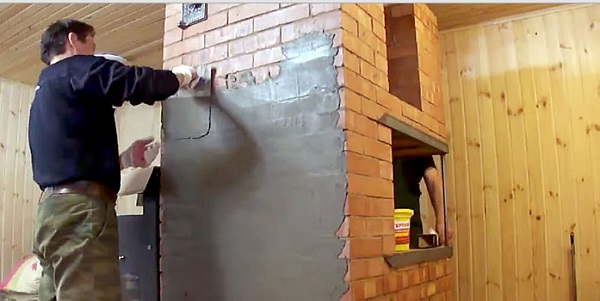
Technology of applying plaster on the furnace surface
After completion of the work, it must pass at least 3 days to dry the solution. It is advisable to include the stove only in a week when the solution is finally strengthened. It is not worth how to speed up the process, there are no drafts or heat guns with warming. Only good ventilation of the entire room.
If it is planned to use a decorative putty for furnaces and fireplaces, then it is necessary to apply most often according to the instructions after the main layer is already dropped and covered with a thin crust, but it is still amenable to Nazh.
There is nothing better than a fireplace or a stove in the house, near which you can spend quiet cozy evenings in the family circle. But to create a comfortable atmosphere near the focus only a qualitatively made oven. So during the furnace, its surface is heated, it must be processed by a special plaster.
What are the options for plastering for furnaces and fireplaces and how they apply will be told in this article.
The need and advantages of plaster plastering
It seems to many that plastering work is not necessary, but there are many nuances that talk about the opposite. This is where the furnace finish or a fireplace will be needed:

Important! You can fly up as just folded oven and the one that was built earlier.
Plaster always increases the thickness of the furnace wall, thanks to which the focus cools longer. As a result, fuel consumption is reduced. Due to the plastered surface, the fire safety of the fireplace or the furnace increases, the output of the carbon monoxide is excluded. Plus, plaster is also that the finished surface can be additionally decorated with all known decorative materials.
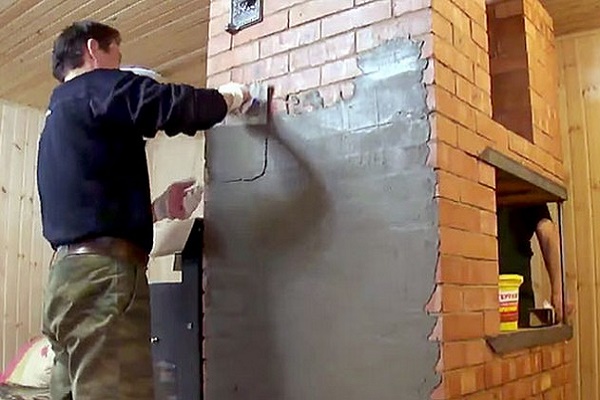
Types of plaster solutions
Now in stores you can find ready-made mixtures for plastering furnaces, and you can also make a solution yourself. But any plaster for decoring the furnace should be resistant to high temperatures and its drops, as the furnace is very heated.
For this, a special refractory plaster for a furnace has been created, which is performed from the reinforcing material capable of putting the finished surface elasticity and strength, as well as protect against cracking and deformation during heat exposure.
Tip! Universal compositions for outdoor and internal work, which in a large assortment are presented in stores, for furnaces and fireplaces are not used, since they do not have refractory properties.
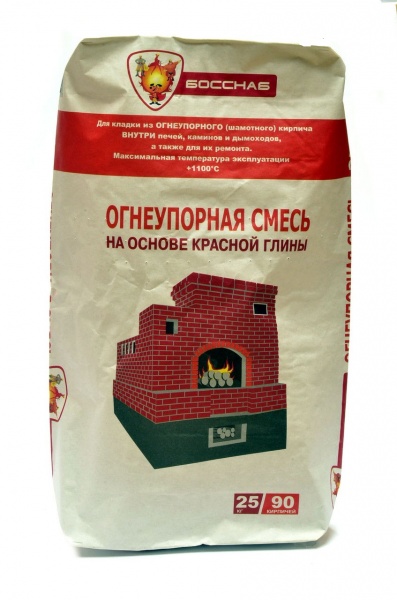
When buying it is worth paying attention to heat resistant mixes Terracotta, "KreatPutz" and others. These mixtures include special components, usually glass, quartz sand, chammed clay or iron aluminate, which give high temperatures resistance.
All solutions that are performed independently can be divided into simple and complex. The first consist only from sand and clay, and the second contains also additional components.
When mixing the mixture with their own hands, the components are necessarily prepared in advance. Sand, for example, sieved through fine sieve, and clay is released from plant roots and small pebbles.
Important! The clay for the solution is selected only fat to improve the grip with the surface of the furnace.

The clay is definitely soaked in water and leaves for several hours. If after this time it absorbed the whole liquid, then you need to add it yet. This is done until the top on the clay remains 10-15 cm of water. After that, it is mixed. Its correct consistency is like a thick sour cream.
Asbestos add a reinforcing effect to the mixture. It can be replaced with finely chopped straw, or fiberglass.
It is very important that only natural ingredients are present in the plaster, which will not be distinguished when the furnace is heated for the organism of vapors and substances.
When the salt is added to the composition, the hygroscopicity of clay increases, which prevents the plaster cracking. Inside such a layer will not appear insects.
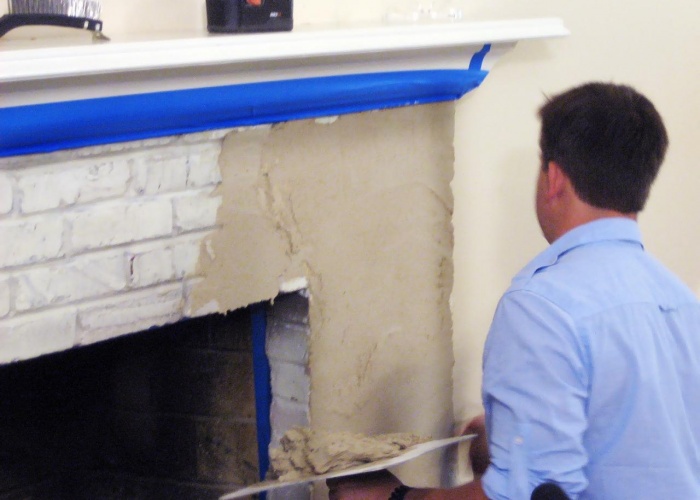
Methods for creating plaster
If it is decided to create a solution for plastering the furnace independently, then it is necessary to strictly adhere to the proportions and recommendations for execution. There are several recipes for the preparation of plastering composition:
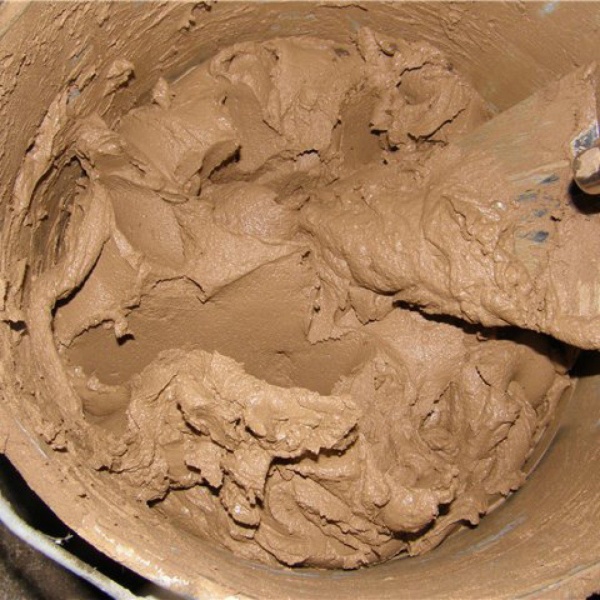
Important! Such plaster needs to be completely spent in 1 hour.
Some solutions for plastering furnaces in a certain proportion are added gypsum. He acts as a fastening agent. But it is worth remembering that the gypsum freezes very quickly. It grips immediately after applying the furnace to the surface. After 15 minutes, the solution with its presence can no longer be used for its intended purpose. In this case, water breeding will no longer help. That is why it is necessary to prepare only small portions of the solution. Such building material is commonly used with lime. She helps him become more durable and faster dry.

In the following video, it is presented independently preparation of a solution for plastering furnaces:
Plastering work with your own hands
Watching the plastering can be done with your own hands, but it is necessary to comply with the work algorithm.
Preparation for plastering
Any surface must necessarily be properly prepared for the application of plaster. There are several steps here:

Cooking plaster
The solution is mixed for stove plaster drill with a nozzle mixer. If a solution is prepared from the purchase mixture, then necessary proportions Powder is bred with water in a suitable container. The resulting mixture is left for 10 minutes, after which it is mixed again and becomes ready for use.
If independent solution is prepared, then it is necessary to do it in accordance with the recipes that were previously given. It is also carefully laid up to a homogeneous mass and becomes ready.

Applying plaster
It is immediately worth notify that the full layer of plaster can be no more than 1 cm. The heat-resistant plaster for the furnaces is applied to a smooth layer from top to bottom for better drying. After setting the plaster, the surface is treated with a wooden grater with circular motions. In case of severe solidification of the composition, it is wetted with water.

Important! Upon completion of the plastering, it is not necessary to hurry with the crossing furnace.
If, in the process of drying, there are cracks on the decorated surface, they are splown with a knife and rub in the same solution. If, after drying, cracks begin appear, then it is necessary to eliminate the cause of this. Usually, the heat-resistant plaster for furnaces and fireplaces can be trapped due to shrinkage, large thickness of the plastering layer and incorrect cutting technology during masonry. But small cracks may appear due to overheating.
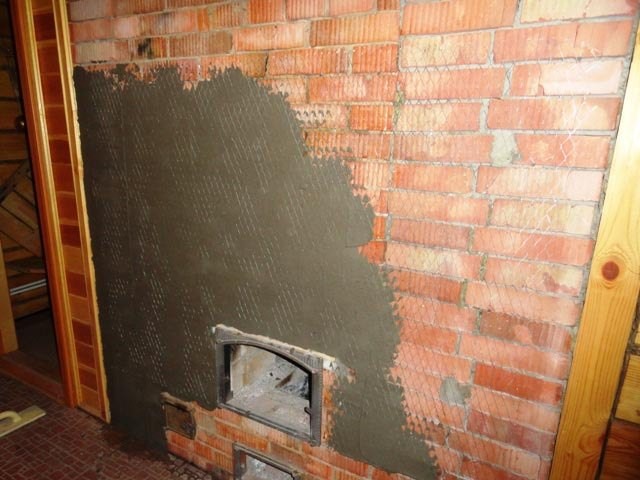
Conclusion
Watching the furnace or fireplace in most cases is required. To carry out this process, it is necessary to approach the most responsible as possible. The main step becomes the creation of a solution for shuttering. Now you can buy ready-made mixes or create them with your own hands. In any case, there are some nuances that are listed in this article.
Properly prepared solution will be evenly applied to the surface, and after the frost it will not give cracks and deformations. A qualitatively decorated home furnace will become a real decoration that will work for a long time without repair.
For decoration of furnaces and fireplaces, a special solution is used, which includes a special heat-resistant plaster for furnaces. It consists of red clay, the coefficient of thermal expansion of which is similar to the red chimney brick.
This means that the appearance of cracks in the masonry and plaster mortar is completely excluded. Also, the mixture includes refractory fillers and alumina cement.
Benefits
This type of finishing material has a number of advantages, among whom it is worth noting the following:
- excellent clutch with a surface;
- convenience and ease of use;
- fire resistance;
- resistance to cracks;
- environmental purity of material;
- lack of asbestos fiber.
The main properties and characteristics of the furnace plaster
- Despite the fact that for good adhesion, the plaster requires a rough surface, there are heat-resistant compositions that are specifically designed for metal. Moreover, the solution applied with a thin layer to 20 mm can last on the surface almost as much as the structure itself will last, and it is an average of about 50 years.
- Refractory plaster has high strength and reliability. It is able to withstand minor blows and small surface deformations. The only and most important condition for high-quality application is a thorough surface of the surface, and the absence of dust on it. (See also Article.)
- Also, the heat-resistant plaster for furnaces is used to arrange not only furnaces, fireplaces and chimneys, but also for cladding boilers.

Requirements for work
- Working with refractory plaster is recommended to test at a temperature of 5 degrees above zero. In addition, at the same temperature, brick itself should be resistant;
- Water used to work should be at least 15 degrees above zero;
- Dry refractory mixtures should be stored in a warm and dry room in intact paper packaging.
Prepare the surface
Important!
Conduct is made only after its dense shrinkage and drying.
- We clean the surface from dirt, lime, paints, fats, and we clean the laying seams about the depth of 3 to 5 mm;

- In order for the solution on the surface to be firmly, it must be applied to the metal grid (photo) with the size of the cells of no more than 10x10 mm;

- The grid is securely fixed to the oven with the help of the twisted ends of the wire, which are laid in the seams during masonry;
- Wire ends are released in a chess order at a distance from 100 to 120 mm from each other.
Council. It is impossible to apply plaster on the painted, plastic, metal and wooden surface.
We prepare a refractory mixture
When preparing a refractory mixture, you need to be limited to so much solution that you can spend over no more than 2 hours. Otherwise, the solution will begin to be captured and will become not suitable for work. The mixture consumption is 1 m2 - 5 kg when applying a layer with a thickness of 5 mm. And how to make a solution, will tell you our instruction.
Method for preparing a solution:
- We mix the dry mixture with clean water room temperature, in the same way as written in the instructions on the package;
- We stir up to the state of a homogeneous mass. (In the mixture there should be no lumps);
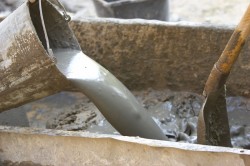
- We leave for 15 minutes;
- We re-mix, and you can start work.
Operating procedure
The solution is applied to the hot surface of the furnace moistened with water in several methods:
- The first layer should be liquid. We are applied as a primer to prepare the surface to apply the remaining layers.
- The second layer is leveling. It is necessary to impart the surface to a smoother and smooth surface.
- The third layer is finishing. Well, if the solution for it is more liquid than the second layer, but the thicker first.
- After applying the finish layer, the surface must be aligned and lured.
Performing work should occur as follows:
- We apply a layer of the finished solution to the surface, after which it align;
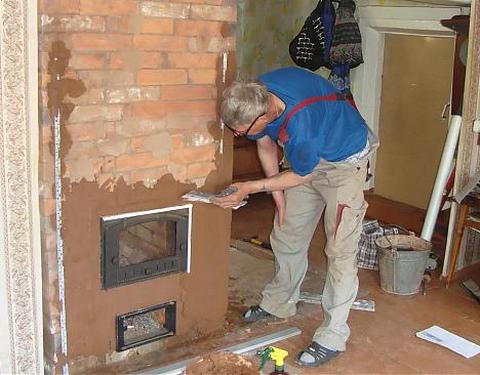
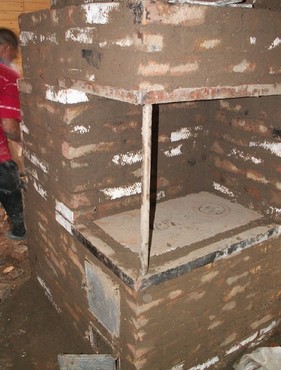
- The optimal temperature regime for work is from 5 to 35 degrees above zero.
Conclusion
Finally, several tips:
- If you perform the repair of an old oven, then you need to carefully clean the surface even from the most imbued spots, as they can continue to manifest themselves on the plaster.
- The burst brick close up with the Mastica Mastica. To do this, it is enough just to fill them with a crack.
It is so easy and simply can be placed with your own hands to the oven or fireplace in country house And save on the services of specialists, whose price for services, not everyone by pocket. We hope that our tips and instructions helped you, and will be suitable in the future. Also do not forget to watch the video in this article.
The simplest and most affordable finishing of furnaces or fireplaces is the application of plaster on their surface. You can prepare a solution yourself or buy a dry mixer ready for use - it will remain only to create it with water and use it in accordance with the attached instruction.
The main stages of the furnace of the furnace plaster
- compliance with optimal conditions for work. The furnace finish is started only in the case when its design was established and is not subject to further shrinkages. The best way - When she already experienced one season, which minimizes the risk of unpleasant surprises. Works are carried out at air temperature and furnaces in the region of 5-30 ° C.
- preparation of the surface. The outer walls of the furnace are cleaned of contamination capable of reduced adhesion of the finishing solution. Special attention is paid to the quality of the seams of masonry. how preparatory activities It is worth considering and fastening the reinforcing grid of steel with a cell of at least 5 × 5 mm;
- preparation of the solution and applying plaster. It is desirable that the minimum temperature of the plaster mortar was 10 ° C. This will provide the necessary viscosity of the solution and increase adhesion to the ground. The finished composition is applied by a thin layer, moving the surface to achieve the desired effect.
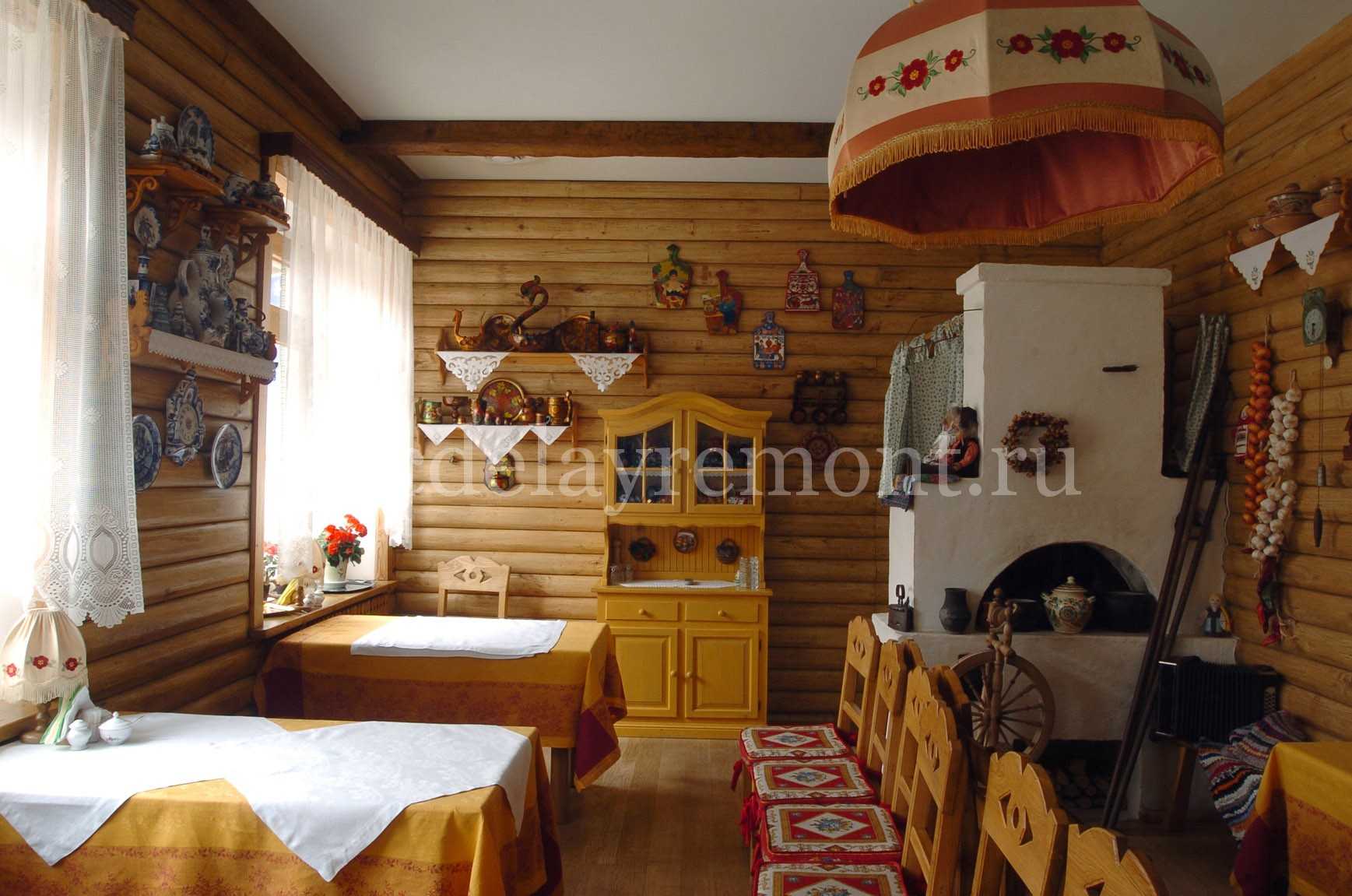
Preparation of homemade solutions
You can meet in the network many different recipes for the preparation of plaster solutions for finishing stoves, but the fact is that their effectiveness remains in doubt. It seems to be reported by specific proportions: 1 clay bucket, 2 buckets of sand, 1 lime bucket - all mix before the creamy state and get a good solution. But in fact, it depends very much on the quality of clay, its species, grade cement, water temperature, etc. etc. In addition, many recipes suggest adding asbestos crumb, which is necessary to enhance the mixture - its reinforcement. These are all old formulations that did not take into account the carcinogenic properties of the asbestos microcolocon.
A little video about how to cook clay plaster for the oven. Just so that you know what should get on fact.
Our advice is to use ready-made dry mixtures with the estimated ratio of components. Under certain conditions, this approach will be more economical than witchcraft over the solution of its own kneading.
Finished heat-resistant mixes
Such specific materials produces a limited number of companies. The table below we led the list of mixtures, information about packing and tentative prices. As you can see, the cost varies in a rather wide range.
| Manufacturer / name | Packing, kg. | approximate cost | |
|---|---|---|---|
| Terracotta | |||
| A mixture of plaster heat-resistant | 5 | 145 rub. | |
| 25 | 475 rub. | ||
| Glue heat-resistant reinforced | 5 | 155 rub. | |
| 25 | 530 rub. | ||
| ORTNER | |||
| Hraftmer | 20 | 4000 rubles. | |
| HAFTMER CREAM | 4100 rub. | ||
| Plaster | for tiled stoves | 3900 rub. | |
| modelable heat-resistant | 1650 rub. | ||
| to create highly smooth surfaces | 2900 rub. | ||
| Pechsk. | |||
| Plaster for household furnaces and fireplaces | 20 | 420 rubles. | |
| Glue heat-resistant for household furnaces and fireplaces | 20 | 520 rub. | |
| Cline refractory | 20 | 450 rub. | |
| Stovetonit | |||
| Supercohol Ognet. | 4 | 210 rub. | |
| 20 | 700 rub. | ||
It can be useful:
- The amount of sand add to the solution depends on the clay consistency. What it is greater, the more sand is needed to achieve the required viscosity values. Typically, the ratio of these components is 1G to 2P - 1G to 3P.
- To maintain the properties of plaster, the solution must be intermitted periodically. When using ready-made mixtures, it is impossible to neglect the recommendations of the manufacturers and shut it with a large volume of water than is indicated in the instructions.
- The wall along the perimeter of the coat door is better to bind with a special tile, and not shuffle. This is due to the fact that the door heats up strongly, which can affect the furnace of the furnace - the coating sooner or later falls off.
- Unlike the alignment of the walls, when finishing the furnace layer of plastering should be minimally possible - than it is smaller, the lower the probability of cracking the layer. Typically, the upper limit is set to 10 mm. The use of some expensive compositions allows you to increase this value up to 50 mm.
About improving the adhesion of the foundation
From how fastest layer of plastering will be fixed on the basis depends on the durability of the finish. But under normal conditions, the solution is very bad on smooth brick masonry. You have to resort to additional measures:
- removal of a layer of masonry solution from seams to a depth of 10 mm. This will increase the wall area, which will come into contact with the plastering solution. Among other things, small protrusions will allow evenly distributed the load from the finishing coating over the entire surface of the furnace or fireplace;
- fooling the wall with a composition that increases adhesion. It can be a fatty clay solution diluted to a kefir state. The liquid cement solution is also used, which is applied by spray. A number of specialists advise to use special primer deep penetration
On the reinforcement of the finishing layer
The ideal is the option in which with the future finish, it was decided on the furnace laying stage. In this case, it is possible to provide wire editions of 50 mm long for fastening the steel grid to them, better if it is galvanized material. Releases make every 300 ... 500 mm in a checker order. Otherwise, the fastening with self-draws or nails on the seams. The basic requirement is to ensure reliable fixation of the grid. You can use a woven metal network with a cell of 5 × 5 ... 20 × 20 mm, and the result must be achieved, at which a plaster solution will also be between the reinforcing element and the base surface, without any void.
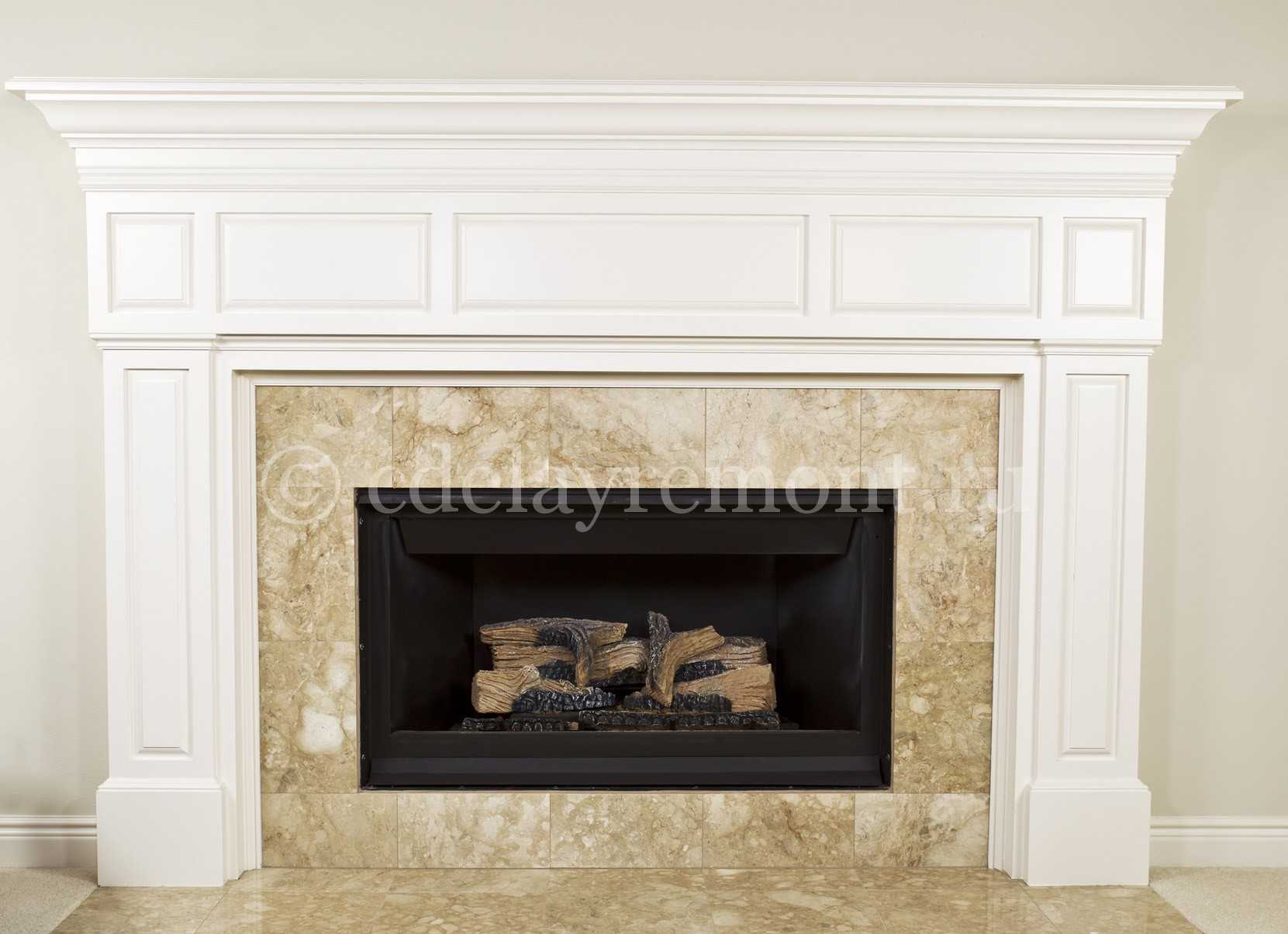
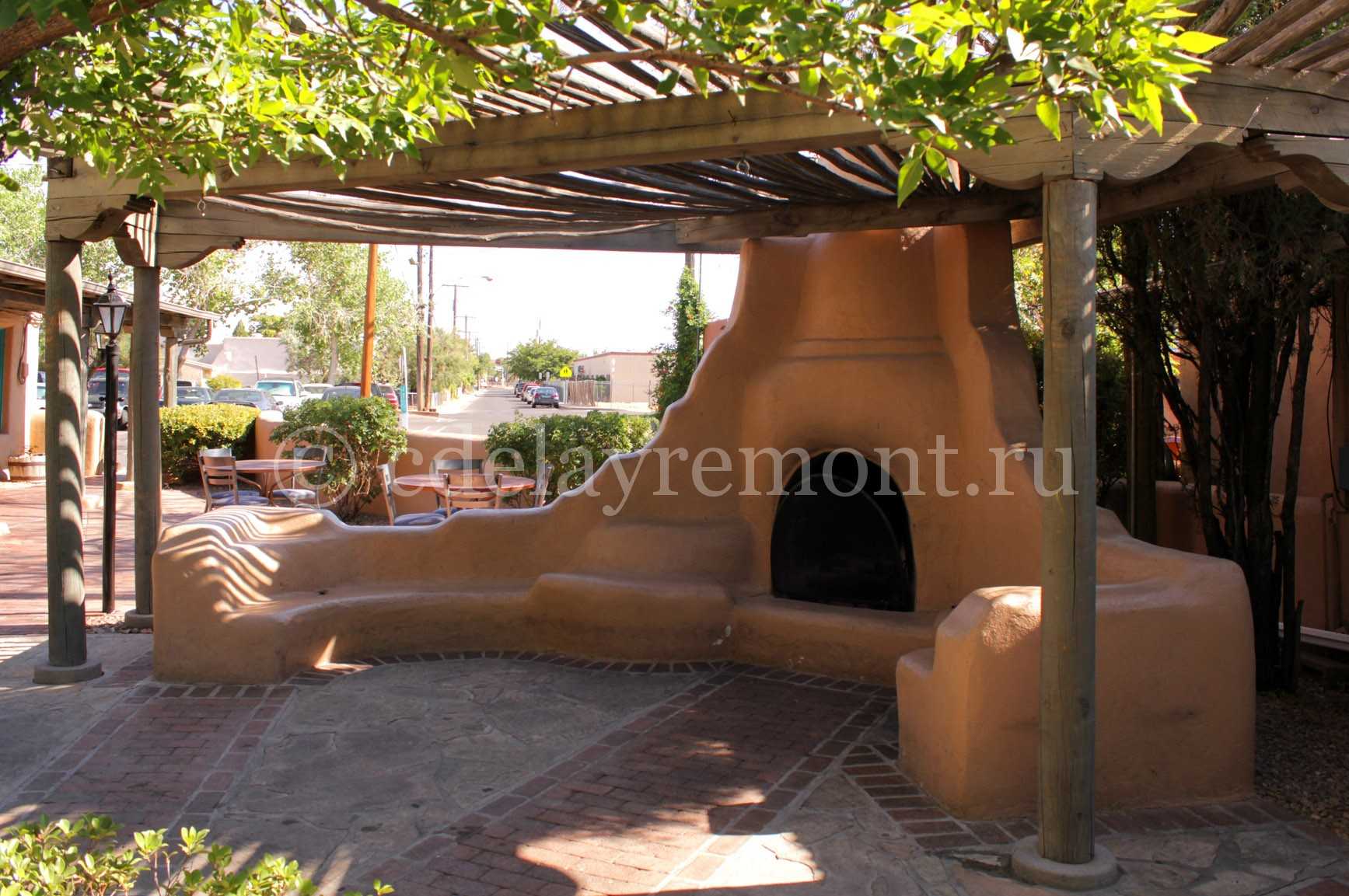
It is not recommended instead of steel products to use any alternative materials - burlap, gauze, mesh of fiberglass. The furnace can warm up uneven, so combustible or melting items in its finish are inappropriate.
Examples of approaches to work
Pre-grind the surface of penetrating acrylate primer. After drying it with self-draws for thin plates (self-pressing sulfur) fasten the metal reinforcing grid. The mount is carried out in a chess order in a masonry seam to a depth of 50 mm. The grid must defend a few millimeters from the wall. Bending the selected heat-resistant mixture, it is applied with a smooth layer on the grid, achieving the overall thickness of the plastering layer not more than 10 mm. Do it better in several stages, layers. Before applying each subsequent layer, the surface is ground. At the end of the level walls, it is possible to apply decorative plaster or heat-resistant LKM.
For the finish, it is quite possible to use heat-resistant glue used when cladding tiles. It is desirable that the mixture contains fibrous components. The order of work looks about the same as in the case above.
Hello everyone. With you again, I, Maxim Aleiniki.
Surely you are already thinking about how to reflect your already existing or plans only furnaces or fireplace. So, the most optimal option is considered to coating the surface of the furnace by plaster. But many materials are much, and you need to choose the one that will bring satisfaction on the results of the work. Agree? I think yes. No one wants to spend time and means to see not at all expected.
So I decided to devote my article exactly finishing materiallike heat-resistant plaster for furnaces. It has a number of distinctive features, including:
- it is not bad to go to many types of surfaces, including smooth;
- does not have warmness;
- reliably holds even on a slightly deformed surface;
- coverage of this material It is able to withstand even the mechanical impact of a small force, provided that the application technology is observed;
- when fires can restrain the fire.
Separately, I would like to say about the properties of the heat-resistant plaster.
- does not miss the carbon monoxide in case of cracking of the masonry material and prevents insects and bacteria in it;
- it does not contribute to the occurrence of bad odor when the furnace or fireplace is heated due to the fact that the smooth surface of the heat-resistant mixture does not give dust;
- to improve the appearance, heat-resistant plaster can be painted or lining.
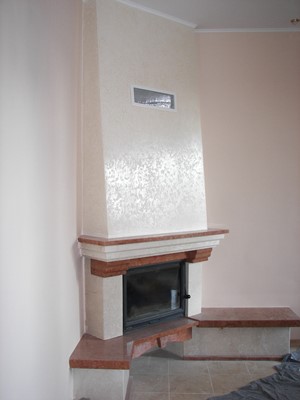
Nowadays, you can buy heat-resistant mixtures without difficulty, only by contacting a specialized store. However, if desired, you can independently prepare a solution of the composition at all not worse. All recipes are usually similar, but it is worth considering the quality of clay, its kind, cement brand, water temperature and much more.
The prepared mixtures have a number of advantages in front of homemade, in my opinion:
- high degree of plasticity
- easy to use and ease in the distribution over the surface
- large expansion coefficient, which allows you to crack
- for a long time save a good appearance
- resistance to comparative low temperatures
- relatively inexpensive price
- high resistance to high temperatures.
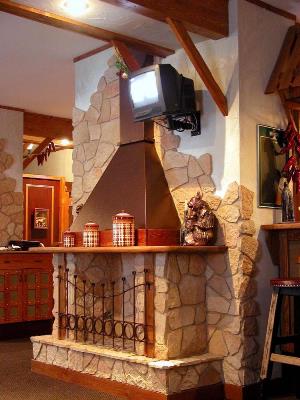
On the modern market building materials You can meet different mixes, among which there are already sufficiently popular. To those can be attributed:
PLANTONITE - SUPEROGNEUPOR - The composition includes heat-resistant fibers and adhesive components. Able to withstand high temperatures and does not crack
ORTNER - distinguish three types:
- for tile design;
- simulated (takes an textured surface to which the picture can be subsequently subsequently);
- smooth (if you want to paint the oven or fireplace).
RathhefnerPuts - applied in the role of finishing plaster, does not crack and withstand temperatures up to 200 degrees.
Terracotta - Composition: clay, chammed dust of heat-resistant binding additives. It is used both for furnaces and for fireplaces of bricks: (chamotte or ceramic). It will maintain a temperature of up to 200 degrees.
Lacker - lime, sand, plaster, asbestos, cement, clay and mineral supplements. The disadvantage is the content of asbestos, but is able to withstand up to 600 degrees.
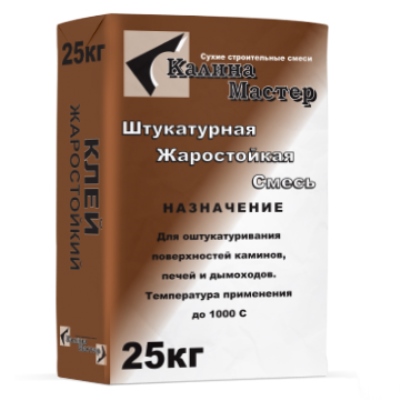
The heat-resistant plaster can be divided into two types:
- Simple - the composition includes two components: clay and sand.
- Complicated - contains three or more ingredients.
- Clay + Sand + Asbest
- Same + lime;
- Sand, clay, asbestos + cement;
- Sand, lime, plaster and fiberglass.
In the process of preparing the mixture, we simply mean that asbestos allocates malicious substances, so it is better to add fibrous reinforcing additives into the heat-resistant plaster. Such as fiberglass.
And the technology of cooking the mixture is simple. For a simple mixture, seek sand, mix it with clay, pour into the container, add the water and stiritate the mixer to a creamy state.
The proportions with the composition depend on the fatty clay. With high fatty it, 3-4 pieces of sand per part of clay are added. I understand that not all of you are asces in this matter, so I will share how to determine the fat content of clay. It will not take a lot of time and effort:
- put a little clay in a bucket
- pour water
- simultaneously stir until the consistency is obtained sour cream
- mind a slight solution with a slight solution
- if the clay covered the surface of the board for 1 mm, then a non-large, thicker layer - fat.
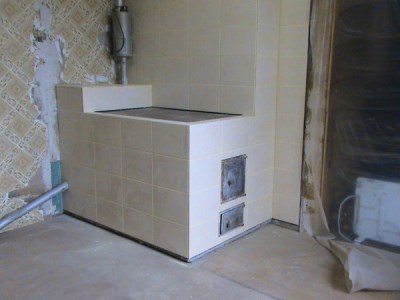
Concerning complex solutions, I can offer several non-hard recipes:
- Clay, lime - 1 share; sand - 2 shares; Reinforcing additive - 1/10 share. To sift everything, mix in dry, pour water and stirring, bring to the state of sour cream.
- Clay - 1, sand - 2, grade 300 and more -1 cement, reinforcing additive - 1/10 part. Also sift everything. Mix clay and sand, add water and stir up to the state of thick dough. Add cement reinforcing additive, mix and fill with water so that the creamy state of the mixture is.
- Gypsum -1 share, lime - 2, sand - 1, reinforcing additive - 2/10 shares. We are sifted, mix the sand, lime and additive, add water and stir up to the state of the thick dough. We add lime plaster and water. I bring to a creamy state. It is important to remember that the gypsum quickly freezes. Therefore, a lot of soles are not prepared, as it must be worked out for 5-6 minutes.
In any case, whatever you decide: to acquire ready Or make it personally, know that work with such plaster should be made at a temperature mode from 5 degrees above zero. Moreover, the brick must be set aside at the same temperature. Water planning to use to work should be at least 15 degrees above zero. Fireproof dry mixes need to be stored in a warm and dry room in a paper container without damage.
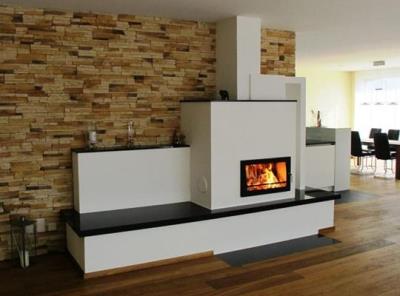
Take advantage of the councils and your work will be fruitful and quality.
On this I say goodbye to you, dear visitors to my blog. Bye Bye.




